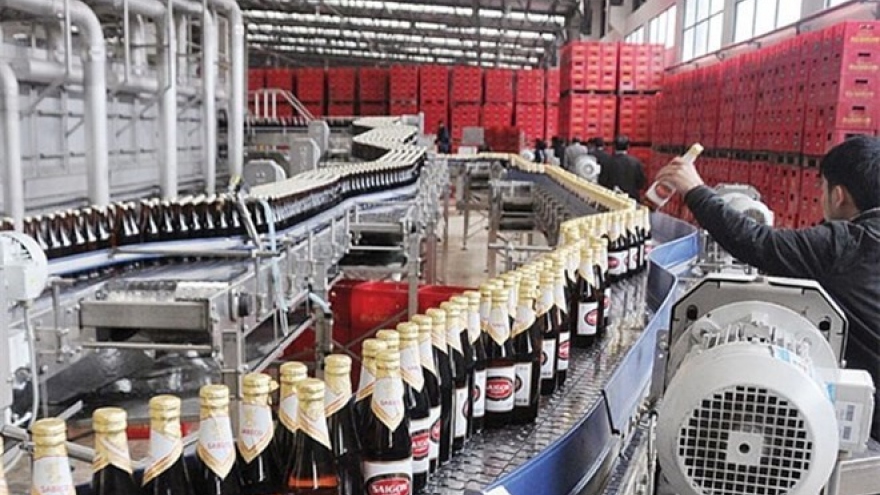Vietnam’s thirst for beer has global giants eager for a taste of the market
Every evening, large groups of workers and friends gather for lager and snacks at a beer garden along Quang Trung Street in Hanoi.
“Drinking beer is part of our culture,” said Le Tuan Linh, 32, a PR manager at a property business. He and his friends often start the evening with “1-2-3-Zo” before each downing a glass of the amber nectar.
“When we drink beer we can relax, so we often go for a drink after we leave the office,” he said, hoisting a mug of draft beer.
 |
| Men drink Sabeco's Saigon beer on a roadside restaurant in Hanoi, Vietnam November 29, 217. Photo by Reuters/Kham |
Vietnamese people also have a habit of discussing business over a beer, and the more lager downed, the closer they move to a deal.
Vietnam’s beer-friendly culture stands out compared with other emerging Asian countries like India and Indonesia. In Hanoi, streetside draught beer is as common as coffee.
This market for beer is becoming ever more attractive to global giants that have been racing for stakes in local brewer Habeco and its bigger rival Sabeco, both of which the Vietnamese government plans to privatize.
Recently, Thai Beverage bought a majority stake worth US$4.84 billion in Sabeco.
Thai Bev’s local unit, Vietnam Beverage Co Ltd, won the 54% Sabeco stake on offer at an auction last month.
The Sabeco deal is expected to help Thai Bev tap into Vietnam’s beer market, worth about US$6.48 billion last year, where a young population and booming economy counter the drawbacks of political resistance, a high minimum bid price and a cap on foreign ownership.
The Thai owner of Sabeco plans to increase the brewer’s annual output to 1.9-2 billion liters of beer in 2018 from 1.75 billion liters in 2017, said company execs.
 |
| A man pours Saigon beer to cups in a restaurant in Hanoi, Vietnam November 15, 2017. Photo by Reuters/Kham |
The domestic market share held by Sabeco is also expected to increase to 50% from 40% on the strength of Thai Beverage’s retail network.
Many international brewers, including Australia's leading beer company Carlton & United Breweries and Denmark’s Carlsberg, have expressed interest in acquiring shares in Habeco, Vietnam’s third-largest beer company by sales.
Carlsberg has already edged closer to reaching an agreement with the Vietnamese government to increase its stake in Habeco. The brewer, which already owns 17.3% of Habeco, has been discussing its priority purchase rights with the Vietnamese government for years.
“Carlsberg, the Vietnamese government and Habeco have reached a common understanding on a number of issues during the negotiations, and we expect this will accelerate the process,” Reuters quoted a Carlsberg spokesman as saying.
The government said last month it expects a stake sale in Habeco to be completed in the first quarter of 2018.
Brewers’ paradise
Vietnam has one of the world’s most attractive beer markets, buoyed by a young population that consumed nearly 4 billion liters last year.
An expanding Vietnamese middle class and youthful population have helped drive a 300 percent surge in beer demand since 2002, according to market research group Euromonitor.
It estimated per-capita consumption reached 40.6 liters in 2017, making Vietnam the biggest beer consumer in Southeast Asia.
According to research group Nielsen, the market for canned and bottled beer, not including draft, is worth US$2 billion a year, accounting for 23% of Vietnam’s total fast moving consumer goods market, and growing in double digits.
“We call it a superstar category,” said senior executive at Nielsen Cao Thuy Linh. Brewers have benefited hugely from Vietnam’s growing thirst for beer.
The market share of Dutch group Tiger and eponymous brands in Vietnam increased to 23% in 2015 from 17% in 2009, according to market research organizations Canadean and Bernstein.
The Financial Times quoted Andrew Holland, an analyst at French bank Societe Generale, as estimating that Vietnam accounts for 10% of Heineken’s profits, and is its second-biggest generator of earnings after Mexico.
The local beer market is expected to thrive in the coming years as the Vietnamese thirst grows.
Vietnam will represent half of Japan’s Sapporo Holdings Ltd’s overseas beer sales in the next decade, Bloomberg quoted Mikio Masawaki, general director of Sapporo’s Vietnamese brewing unit, as saying.
At the crowded beer outlet, with young female waitresses wearing short skirts displaying the logos of local and international brewers, Linh said he will continue to drink beer with friends two or three times a week.
“They are happy times for me,” he said. “There's not much entertainment around here, so if I did't drink beer I don't know what I'd do with my free time.”



